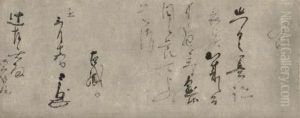Oribe Furuta Paintings
Oribe Furuta, born in 1544 in Japan, was not only a prominent figure in the world of Japanese tea ceremony (chanoyu) but also a skilled samurai and a master of the art of war under the great warlord Toyotomi Hideyoshi. His full name was Furuta Shigenari, though he is better known by his tea name, Oribe. His contributions to the Japanese tea ceremony are immense, transforming it into an art form that combined aesthetics, philosophy, and the tactile joy of tea. Oribe's influence extended beyond the tea room into ceramics, garden design, and the broader spectrum of Japanese aesthetics.
Oribe's life was marked by the turbulent times in which he lived, encompassing the Sengoku period—a time of social upheaval, military conflict, and political intrigue in Japan. Despite his martial background, Oribe found himself deeply drawn to the cultural pursuits prevalent among the samurai class of the time, notably the tea ceremony, which was evolving into a sophisticated blend of ritual, art, and a means of political and social networking.
Under the tutelage of Sen no Rikyu, one of the most revered figures in the history of the Japanese tea ceremony, Oribe's understanding and practice of tea deepened. After Rikyu's forced suicide by Hideyoshi, Oribe's position became increasingly significant, as he navigated the complex social and political landscapes of his era, eventually serving under Tokugawa Ieyasu, who established the Tokugawa shogunate and ushered in a period of relative peace and stability in Japan.
Oribe's innovations in the tea ceremony are characterized by his bold and inventive style, known as Oribe-ryū. This style is especially evident in the Oribe ware ceramics, distinguished by their irregular shapes, vivid green copper glaze, and playful, sometimes whimsical designs. These ceramics broke from the more restrained Raku ware favored by Rikyu, reflecting Oribe's innovative approach to tea aesthetics. Oribe also contributed to the development of the Kirei-sabi aesthetic, which embraced a more colorful and lavish style compared to the wabi-sabi aesthetic of his mentor Rikyu, thus broadening the scope of tea ceremony aesthetics to include a wider range of expressions and tastes.
Oribe's death in 1615 marked the end of a significant chapter in the history of Japanese cultural arts. His legacy, however, lives on through his contributions to the tea ceremony, Japanese ceramics, and the Oribe-ryū school, which continued to influence Japanese aesthetics and culture for centuries. Oribe Furuta remains a pivotal figure in Japanese art history, embodying the complex interplay between martial prowess and cultural sophistication that characterized the samurai class during Japan's feudal era.
